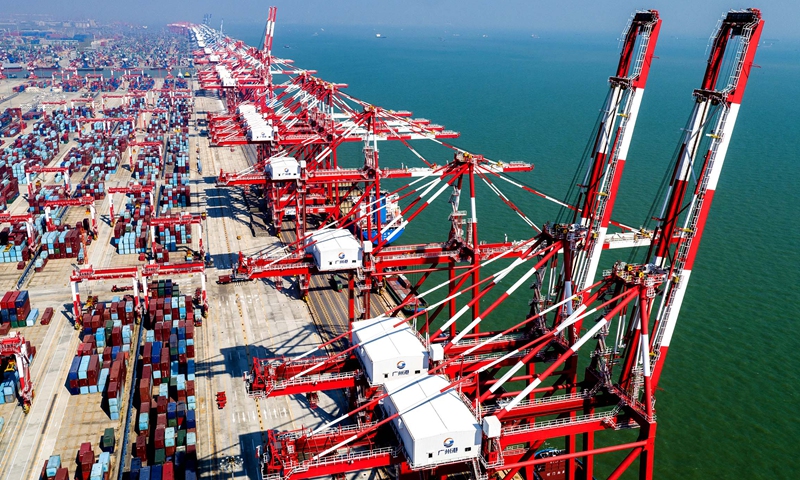Chinese port operators are banking on technology investment and better services to improve their efficiency against stiff headwinds in global trade, and their resilience could serve them well when conditions improve, port operators and industry insiders told the Global Times.
By tapping digitalization and automation and working on modes such as new shipping routes and cold-chain logistics, several leading Chinese ports have seen marked growth in turnover, bucking downward pressure in foreign trade.
According to a Monday report by the Guangzhou Daily, the city of Guangzhou, capital of South China’s Guangdong Province, aims to become a national-level comprehensive logistics center.
A fully automated facility at the Guangzhou Nansha Port handled more than 920,000 containers in its first year of operation, with intelligent guided vehicles (IGVs), cranes and container trucks all guided by a central operation system, making the port one of the world’s most efficient with an annual throughput equivalent to 24 million standard containers.
“The IGVs, guided by the domestic BeiDou Satellite Navigation System, have L4 level autonomous driving capability, and they can transport containers with precision,” Huang Binglin, a manager at the port, told the Global Times.
The application of IGVs at the wharf with four berths accommodating 100,000-ton ships could save 100 million yuan a year ($13.78 million) in labor costs, Huang said.
In the first seven months of 2023, the Guangzhou Nansha Port handled 162,000 standard containers under sea-rail multimodal transport, up 244.7 percent year-on-year, according to the port.
Such an improvement in efficiency and business scope can be seen in other ports.
In the Ningbo Zhoushan Port, operators increased business by expanding the service radius and adding capacity. In July, the port handled 70 containers fully loaded with motorcycles produced in Southwest China’s Chongqing Municipality, some 2,000 kilometers away, and sent the cargo to sea.
In the first half, the port has handled 679 million tons of cargo, up 6 percent year-on-year. For containers, an annual growth of 1.2 percent was recorded.
By adding offloading capacity via pipelines, the Port of Yantai in East China’s Shandong Province handled 30.76 million tons of crude oil in the first seven months, up 27.75 percent year-on-year.
Experts said Chinese ports’ transformation from quantity-driven to quality-driven has been a prominent trend in recent years.
“In terms of the scale, scope and capacity of smart applications, it is safe to say China in this regard is unrivaled anywhere in the world,” Zheng Ping, chief analyst of industry news chineseport.cn, told the Global Times on Monday.
“While there are only several smart wharves in the US, China has 10-20 wharves installed with smart capabilities, powered by 5G and a series of high-tech applications,” noted Zheng.
In June 1, Fitch Ratings said it expected global trade to grow by 1.9 percent in 2023, sharply down from 5.5 percent in 2022.
Amid the complex and austere external situation, China’s foreign trade grew just 0.4 percent in the first seven months in yuan terms.
The improvement in efficiency and service will serve as a springboard when foreign trade rebounds and Chinese ports will be the most ready to tap that trend, Zheng said, noting that Chinese ports are quite unlikely to face jams such as those seen in the US and Southeast Asia.
Ports in China handled a combined 8.19 billion tons of cargo in the first half of this year, up 8 percent year-on-year, mainly driven by commodity imports such as coal, MOT data showed on July 31.
(Global Times)




